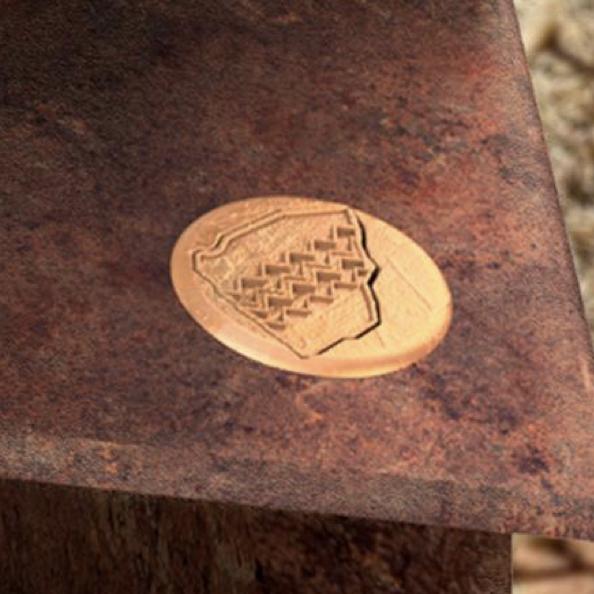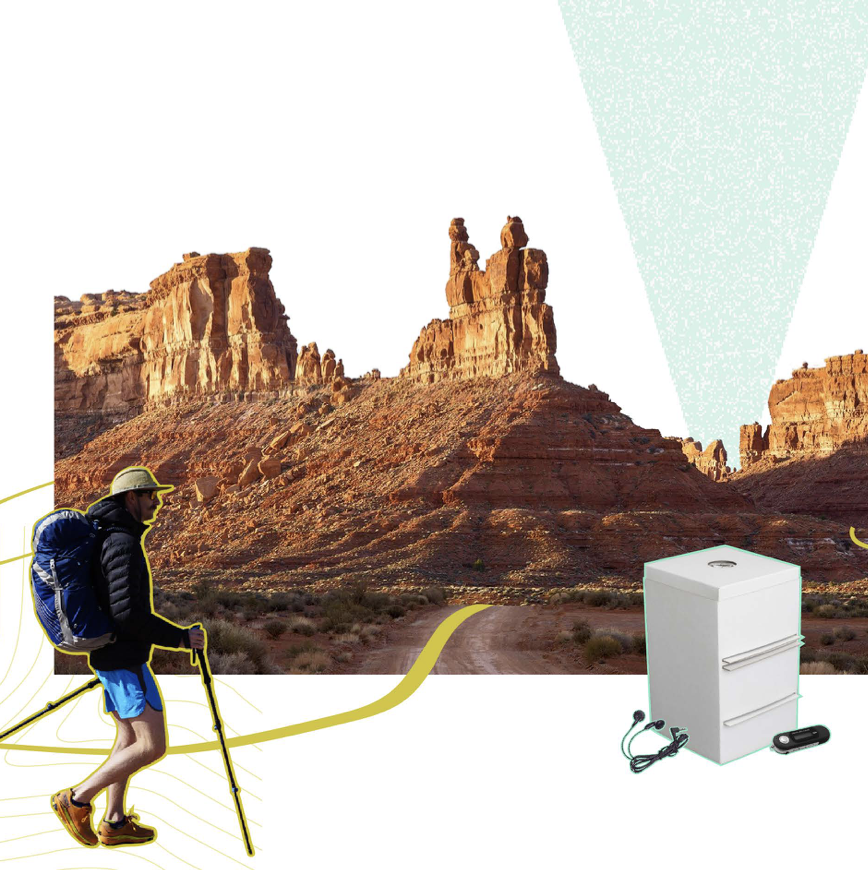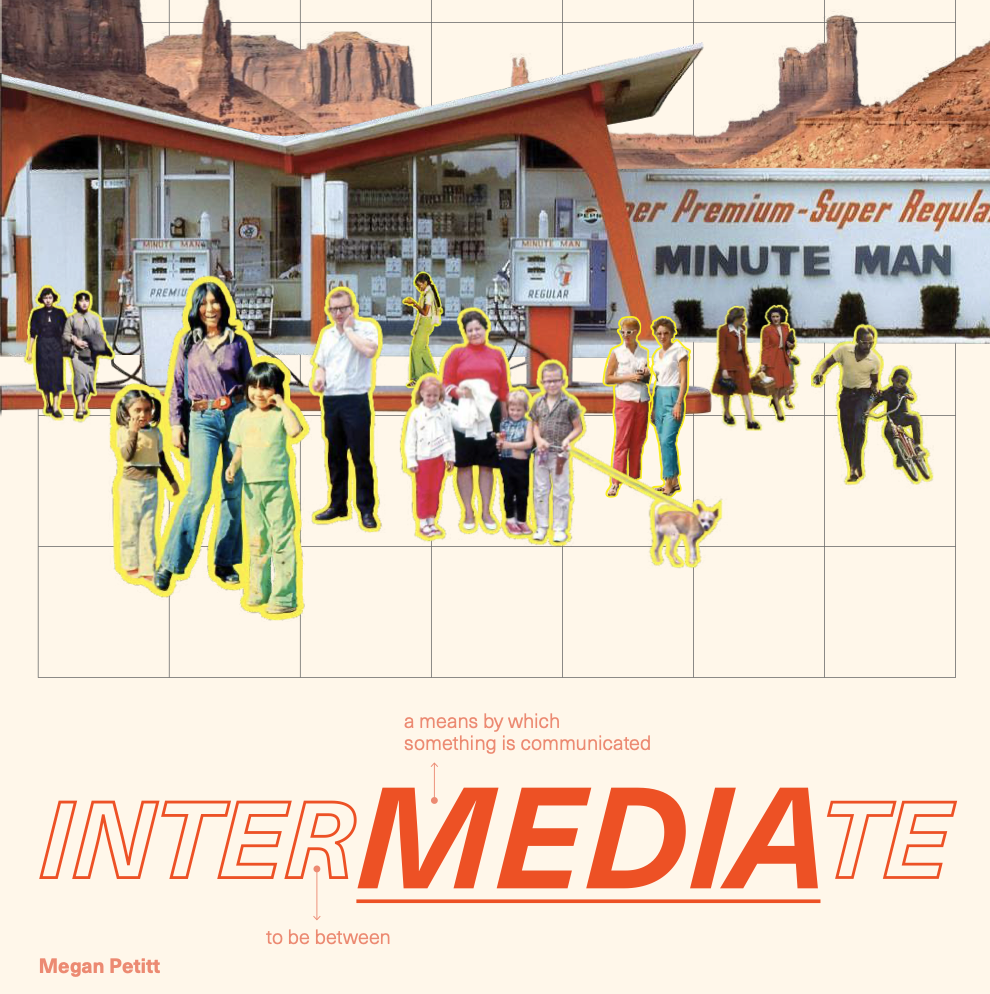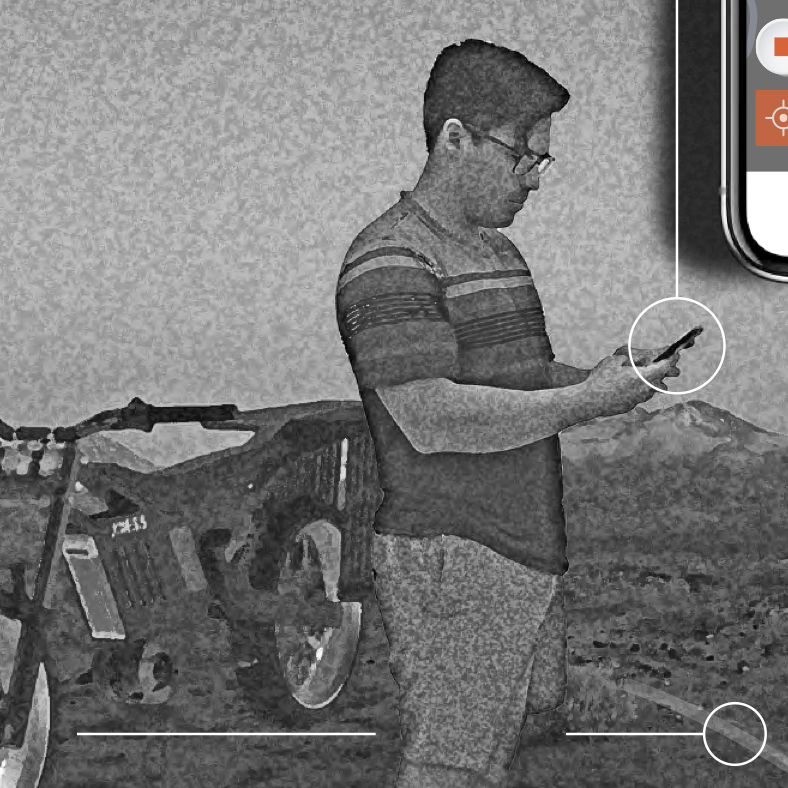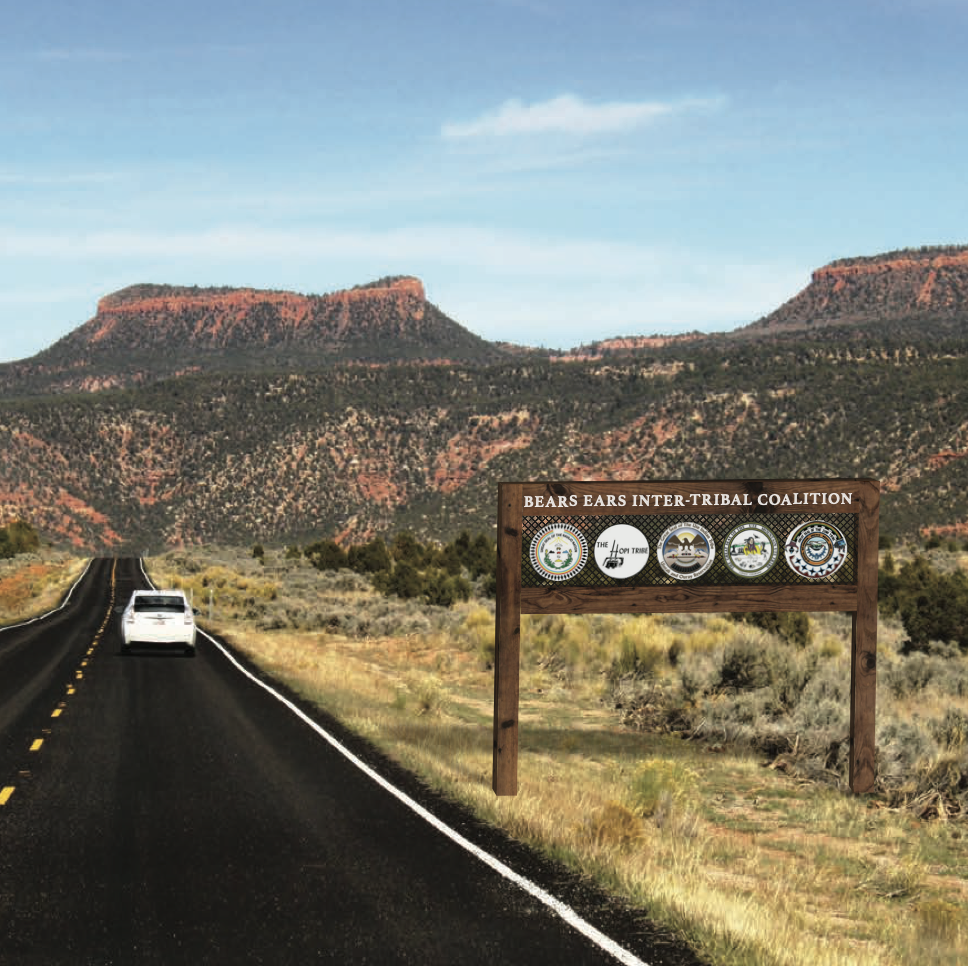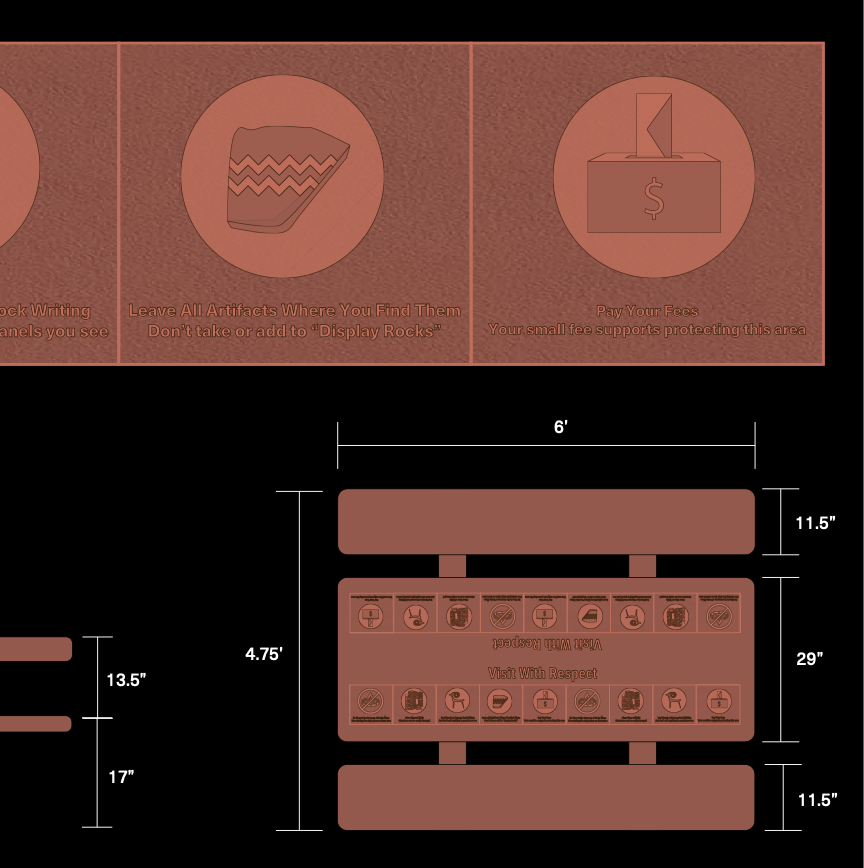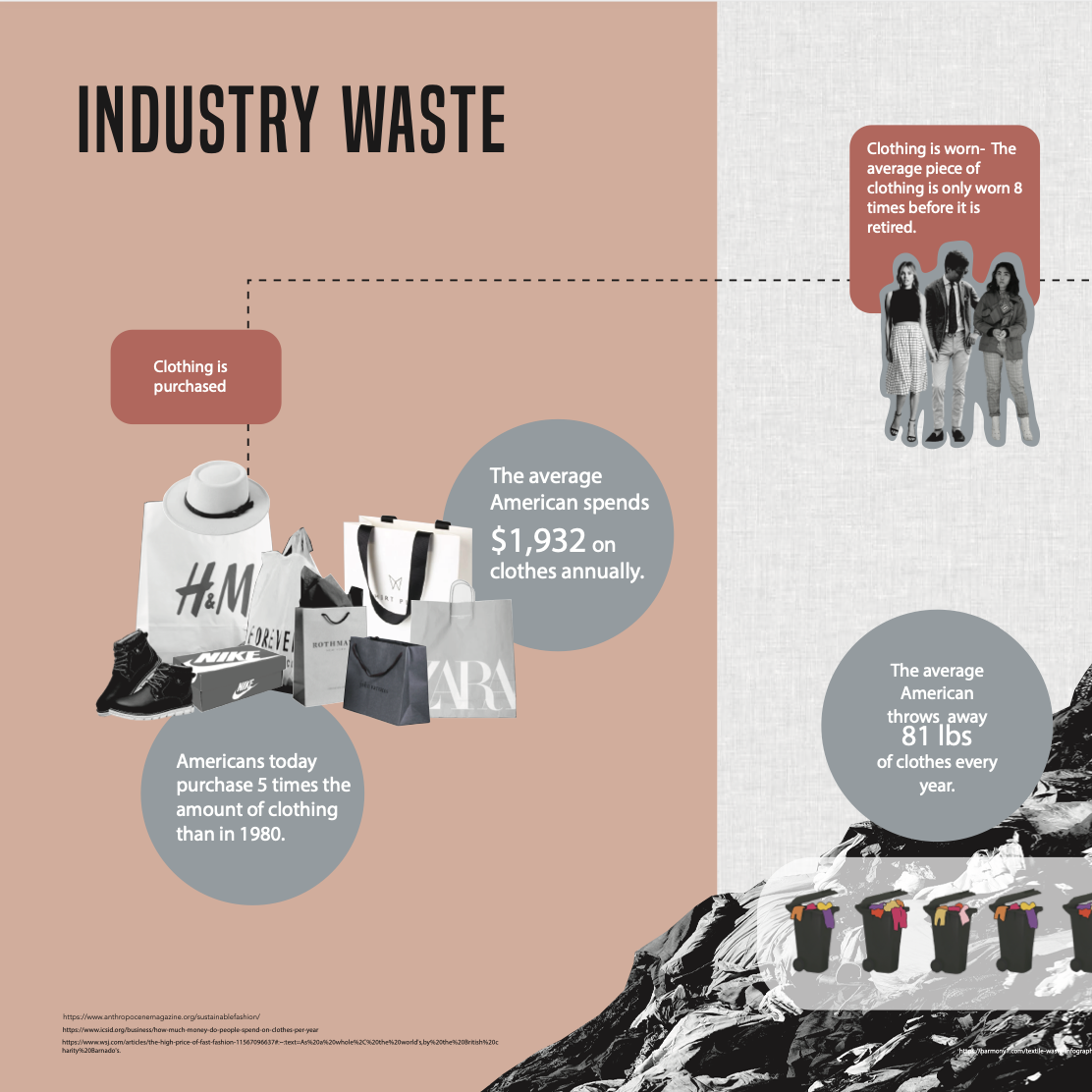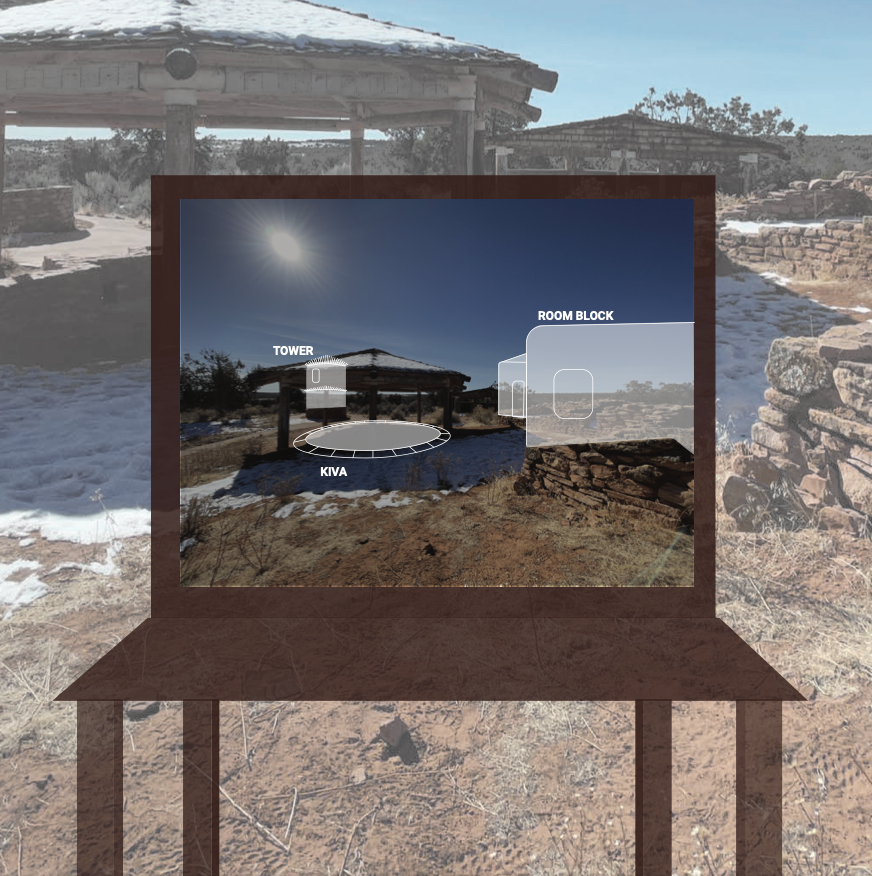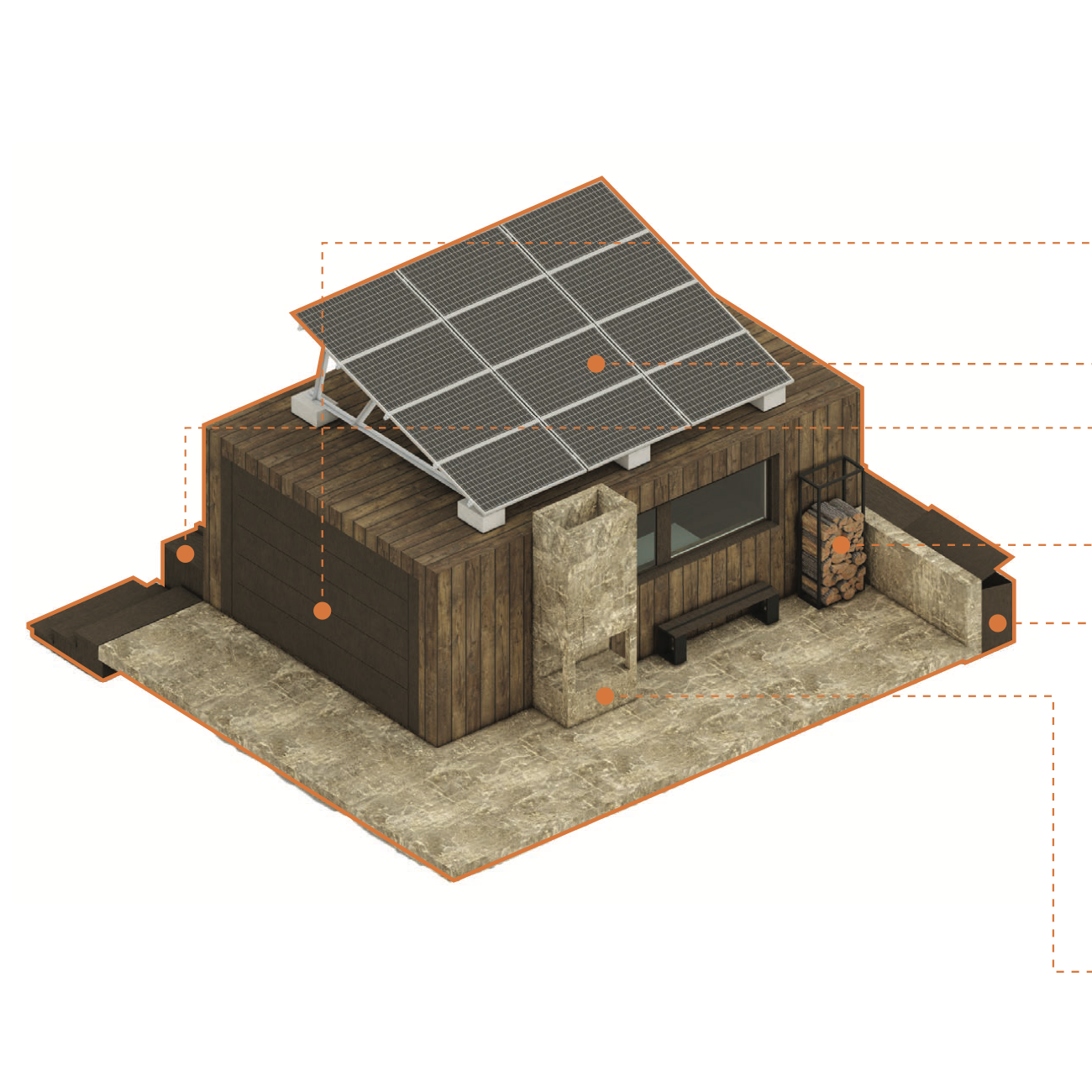Tree Olla (this is the way) / Steven Erb / Fall 2021
The hybridization of drip systems and traditional ollas creates a revolutionary product that focuses on conserving water. The hexagonal, modular design mimics a natural system that can be used as a space to sit and reflect. In addition, these ollas have been elevated to the surface as a reminder that water is the most prominent and invaluable resource for all living species.
Visit With Respect Experience Markers / Zachary Bailey & Lyndsey Erickson
/ Spring 2021
Mule Canyon as an Educational Center. This project’s intent is to create a walk through experience for learning the Friends of Cedar Mesa Visit With Respect Principles within the Mule Canyon Interpretive Site.
Illuminant / Rikki Price / Spring 2021
An Audiovisual platform that uses a fold-up projector and audio player to provide a storytelling experience for backpackers, and sheds light on a Native perspective of Bears Ears National Monument.
Intermediate / Megan Petitt / Fall 2020
The onslaught of information available to urban dwellers that has accompanied the rise of the digital age is hard to understate. But beyond metropolitan areas—many characterized by rugged landscapes and dispersed populations—how are rural citizens communicating vital information when internet, printed media, and TV news aren’t cutting it? Intermediate aims to fill this communication gap by activating an inherent part of rural life— travel— for the task of disseminating and dictating locally relevant information.
Axess / Cody Snow & Navi Guerra / Fall 2020
To help visitors of all abilities access the natural and cultural landscapes within Bears Ears by providing a platform for the rental of site tailored e-Bikes. Such bike will provide transport and education to visitors, funding and control to management, as well as protection to the land.
Mule Canyon Site Indigenous Context / Rikki Price / Spring 2021
The intent of this signage platform is to introduce the 3 context themes to the visitor over time as they make their way to the site: Indigenous tribes are still here, Tribes are not a monolith, and ancestral sites are still sacred to Indigenous people. This allows for time for the context to ‘sink in’ and build upon itself. It also creates an opportunity for visitors to bears ears who are not visiting the Mule Canyon site to gain a bit of context as they drive through the monument.
Beyond the Binary / Chandler Isbell (he/him) / Spring 2022
The natural world and human experience are diverse in sexual identity and gender expression, yet society has been designed to affirm a two-gender binary. To move away from that, I am designing an inclusive sizing system to encourage expression that isn't limited by the confines of gender expectations.
The Inframent / Lucy Allen & Jackson Kerbs / Fall 2019
For the last century, mentions of “the sublime” in literature about Yellowstone have been declining. We aim to bring back the sublime for travelers in Yellowstone by sonifying underground seismic vibrations. The waveforms in the seismic data are sped up into the audible frequency range, compressing weeks of seismic activity into seconds of sound. Instruments at busy areas and on trails play the sound and call visitors into the wilderness.
Connecting to the Time Perception of the Great Salt Lake Non+Humans / Brandon Hoyt (he/him) / Spring 2022
Before the emergence of life on Earth, time flowed independently of a witness. This changed with the emergence of microscopic non+human life in Earth’s deep oceans billions of years ago. The shifting spectrum of sunlight became the metric for the rhythm of the environment. This project works with light to connect humans to the time perception of the Great Salt Lake's descendants of these first witnesses of time.
It’s Nothing Personal / Roxcy Stanley / Fall 2020
A Utah-wide letter exchange in response to common issues like political polarization and new fatigue. By facilitating thoughtful conversations, this program can create more understanding, less polarized communities.
Stretch Your Legs: Visit With Respect Amenities at Mule Canyon / EJ Spence
/ Spring 2021
Site interventions to give visitors of the monument a place to meet up, take a break and be introduced to Bears Ears. As a front country site features will focus on day trippers who want to see a site without a long hike. The addition will invite these individuals to stay longer, eat a meal and learn about Visit with Respect.
Seasonality & Clothing / Sophia Nester (she/her) / Spring 2022
As the fast fashion industry continues to grow, it creates a larger disconnect between humans and the seasons. I aim to use modular clothing as a means of reconnecting humans with the seasonal need for clothing.
InDepth / Taran Egner / Fall 2019
Yellowstone is evolving. What we see today at Yellowstone won’t be the same for future generations, how can we share this experience of a changing landscape while bringing awareness to climate change and its impacts. Yellowstone is changing, every year the seasons are getting shorter and the snowfall is less. Yellowstone Evolve aims to use snow pack data to show how the environment in Yellowstone is evolving through data visualization and an online platform.
Sustainable Steps / Bryan Emerick / Fall 2020
The goal behind sustainable steps is to create more sustainable and longer-lasting earth through the exploration of footwear solutions while focusing on the minimization of trail damage on hiking trails.
BOND - intimacy garment / Mya Nguyen (she/her) / Spring 2022
Examining the dualism between human and nature, BOND fosters a relationship between the two – balancing oppression and expression of the natural body. The BOND corset-like garment arouses intimacy between the wearer and body, whether it be their own or another.
Tea for 2 / Elizabeth Adams (she/her) / Spring 2022
Facilitating a ritual through an experience between the Human and Non-Human with Psilocybin tea.The Human has the ability to reconnect with the natural world transforming an act into a ritual through this experience.
Quieting Yellowstone / Ethan Powell / Fall 2019
Natural sounds are part of a web of resources vital to park ecosystems which are composed of immersive experiences important for wildlife, wilderness and visitors. These sounds are in danger of being overpowered by the sound pollution created by the increasing number of visitors each year. The goal of this project is to design a mask that allows visitors to communicate with each other while protecting the natural soundscape around them.
Made You See / Katya Pogodaeva (she/her) / Spring 2022
Human/ non-human perceptions of the world diverge in many directions including color and the way that we see. Through a speculative subscription-based service I am attempting to create a knowledge-based archival system to expand color experiences beyond human point of view.
Liquid Desert / Ezra Jefferies / Fall 2020
Liquid Desert is dedicated to enabling cyclists to stay hydrated on a wide range of bicycles. Whether it be a week bikepacking through Bears Ears or a weekend adventure on your local singletrack.
HOTR Box / Sumner Swaner / Fall 2018
Yellowstone National Park is a vast ecosystem, and with more than 4 million visitors a year, but how do we make sure the park is healthy? Home On The Range is a community science project that monitors a critical vital sign in the park, Bison. The project aims to improve on how community science is performed and give scientists greater insight into the health of the park.
We Don’t Train The Bison / Magdalena Wilson / Fall 2018
We Don’t Train the Bison
Visitation to Yellowstone Park is increasing enormously every year. With that increase, there are more visitors breaking safety rules and getting injured. One of the biggest increases in reported incidents is bison attacks.
Visitors often see animals around roads and developed areas, and incorrectly assume they are safe or tame. This project is meant to demonstrate to visitors what safe behavior looks like, and what the consequences might be if they ignore safety regulations.
Mule Canyon Pavillion / Eric Maser / Fall 2020
Research for this project began with the intention of improving the site experience for any visitor, whether this be their first or 10th visit to the site. The pavilion response hopes to accomplish two goals in improving the user experience, the first is creating an arrival moment, and the second is creating a space to encourage rest and relaxation which will in turn encouraging people to spend more time at the site.
Experiential Interpretive Signage at Mule Canyon / Kayla Kingsley / Spring 2022
INTERPRETIVE SIGNAGE: a response that allows visitors a respectful, intuitive visitation experience in the form of visual interpretations of the kiva, tower, and room block structures.
Mystery and Infinity / Landon Cragun (he/him)
People learn about the world and themselves from non-human environments. I have examined patterns in natural spaces and have expanded them throughout different scales showing how they can be infinitely repeated. Organizing this repeated pattern to obscure and guide, the new environment will inspire people to explore, learn and contemplate life.
Soundscaping / Zeryab Sial
The Yellowstone ecosystem requires a delicate balance that has been tested by people over centuries. Our presence in the park has forced us to understand our responsibility to the land that we inherit. Of all the resources that we have placed under our protection, sound remains among the most neglected. As the living breath of the park, the soundscape tells the story of the wildlife, geography, and the human all in one exhale. This space is an opportunity for the common visitor to become aware and discover a different sense of Yellowstone.
The Future of Hunting / Eric Maser
Reimagining the Public Lands Hunting Experience in Bears Ears National Monument.
The Wild Spectrum / Erica Fasoli & Zac Kay
The WILD Spectrum is a social movement that challenges the traditional definition of wild. In the past, wild has been viewed as an environment uninhabited and uncultivated by humans. The WILD Spectrum aims to show that elements of wild can exist and thrive in all places and that the preservation of these animals and plants is essential to the human experience. The WILD Spectrum consists of a digital discovery platform and a physical touchstone.

